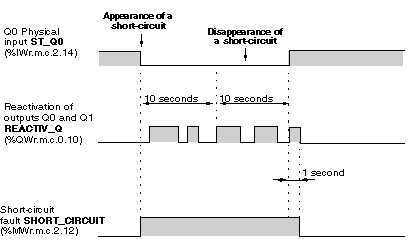When a fault has tripped one or several physical outputs, it is essential to reactivate them. This operation varies according to whether the configuration is set up to be manual or automatic.
When a trip causes an incorrect operation of a PLC-controlled process, it is recommended to link output reactivation to a manual operation (for example: press a button to acknowledge, etc.). The operator can then take the necessary action with regard to the automatic process and personnel safety (e.g. request to change to manual mode).
NOTE: It is possible to program an automatic reactivation, if under the responsibility of the user and PLC-controlled process allowing.
When one of the physical outputs short-circuits, all outputs are set to 0 by the down counting module. In spite of this, as long as the short circuit is present, physical outputs on 0 must be blocked for safety reasons:
-
whatever the mode, (manual or automatic), you must disable output: set physical output enabling bits to 0,
-
in manual mode: program a set to 0 of physical output manual command objects.
Principle of manual reactivation
The short-circuit fault bit is set on 1 as soon as a short-circuit appears. The output reactivation bit must be enabled to reactivate physical output, providing the manual reactivation mode has been configured.
The program can, for example, wait until an acknowledgement button has been pressed before activating this bit.
Reactivation will take effect at least
10 seconds after the short-circuit has been detected, providing that the short-circuit is no longer present. To find out the associated language objects, see
implicit objects and
explicit objects.
The time diagram below shows how a short-circuit is manually acknowledged.
Principle of automatic reactivation
Reactivation is automatically requested by the module every 10 seconds. The basic time of 10 seconds is synchronous in relation to the appearance of the fault.
The time diagram below shows how a short-circuit is automatically acknowledged.

